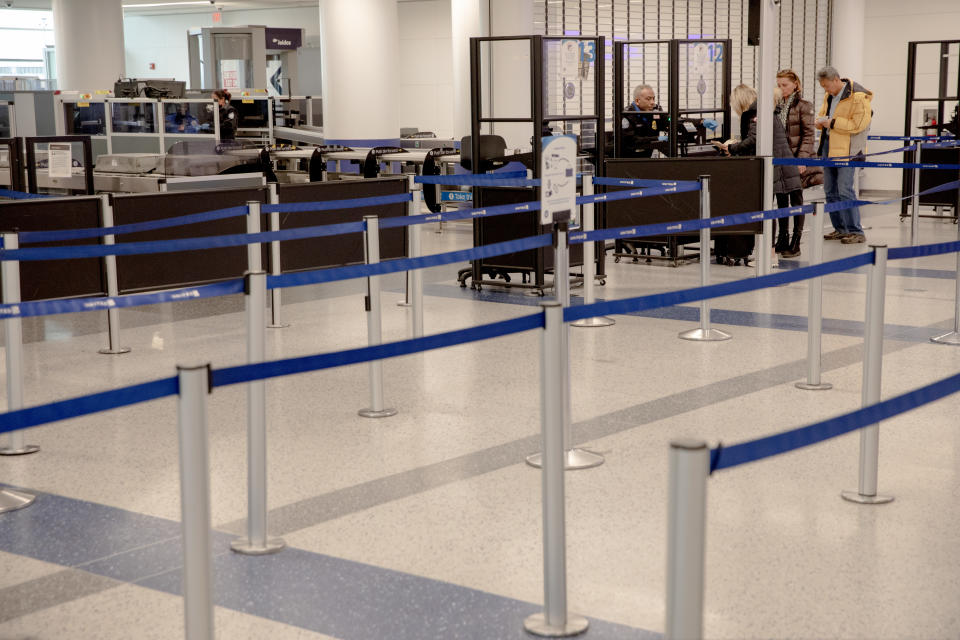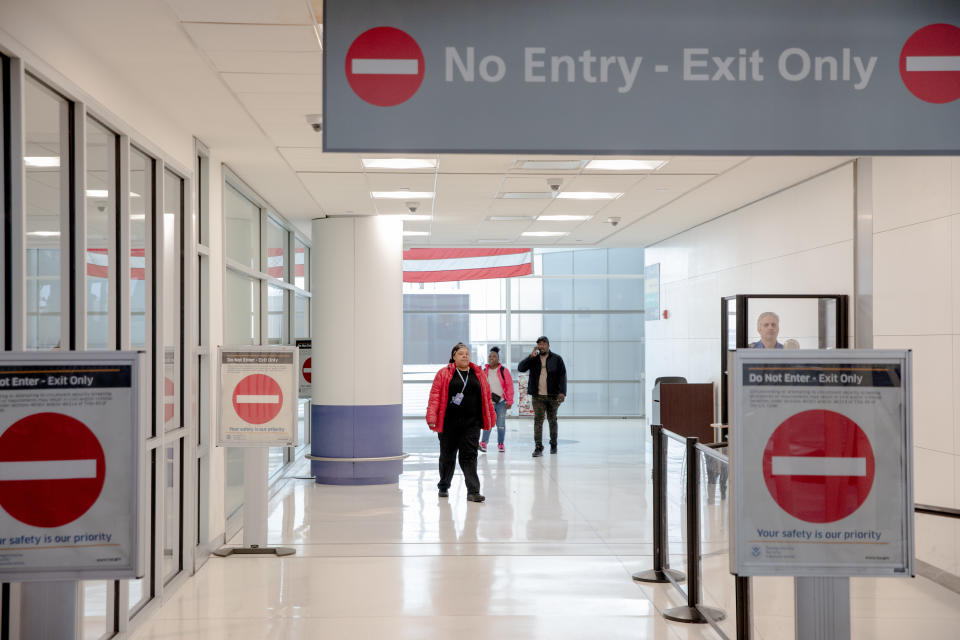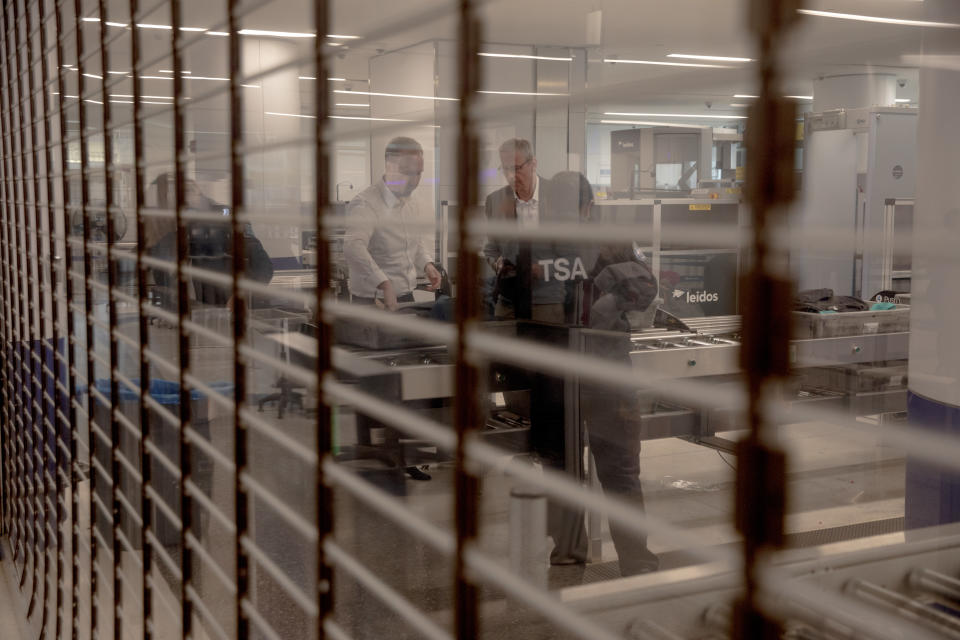Hundreds of people breached airport security in last year, TSA says
Hundreds of people have bypassed some Transportation Security Administration measures at airports in the past 12 months, the agency told The Washington Post, revealing a vulnerability in air travel that has been reflected in a series of incidents.
In November, for instance, two women were arrested at Phoenix Sky Harbor International Airport for breaching a secured exit when they were running late to their flight. Then there was a ticketed traveler at Palm Springs International Airport who walked through an unstaffed body scanner on Feb. 22, leading authorities to evacuate post-security areas as a precaution.
Also in February, a woman at the Nashville International Airport bypassed TSA officers who check IDs and sneaked into the bag-screening line. After her belongings passed through the X-ray, she boarded an American Airlines flight without a ticket. She flew to Los Angeles International, where she was detained by the FBI. She has not been charged; the FBI said it could not comment on a pending investigation.
“It is a larger number than we realized,” said TSA spokesperson R. Carter Langston.
Since March 2023, there have been at least 300 instances of people bypassing parts of airport security, Langston said. He described security lapses as a “trend” that has caught TSA’s attention - and an issue the agency is attempting to mitigate. Security experts say airports and airplanes remain some of the safest public spaces in the United States. But a rise in passengers bypassing security increases the chances, no matter how small, of someone dangerous sneaking through.
TSA declined to share documents that show annual statistics for security lapses or detail individual incidents due to the sensitive nature of information about law enforcement. After this article published, TSA said they don’t consider these incidents to be full security breaches because passengers underwent some checks by airport security or were stopped after getting through.
Since March 2023, TSA reported more than 200 people bypassed “exit lanes” that direct passengers to leave “sterile,” post-security terminals so they can get to pre-security areas like baggage claim and passenger pickup zones. These areas are often marked with “no reentry” signs.
Another 80 people evaded the travel document checker, or TDC podium, where TSA agents review travelers’ IDs and boarding passes. Langston said that amounts to about one person in 10 million. Of that 80, Langston said about 85 percent were stopped in the checkpoint area; all people who were caught skipping TDC podiums were still screened by metal detector or body scanner, he said. TSA said there were 29 lapses in 2019, the last full year of air travel before the pandemic. In 2022, there were 72.
From the incidents TSA reviewed, the agency offered different motives for passengers who bypassed security. Langston said the “vast majority do not seem to have evil intent.” Some travelers bypass checkpoints on accident. Some, like the woman in Nashville, want to sneak onto flights. Others may be tired of waiting.
“A lot of people lose their patience with the line regardless of how long or what the wait time might be,” Langston said.
Thomas Carter, TSA’s federal security director for New Jersey, said unhoused people and people with mental disabilities are among those breaching exit lanes, often because they’re confused. But, he said, most unlawful entries through exit lanes are attributed to absent-mindedness or passengers going back for forgotten items.
“Many times it’s left-behind property; people get very upset, it’s almost like they lose their minds. ‘I have to get my cellphone. I have to get my laptop,’” Carter said.
Carter noted a rise in security lapses in Newark before TSA acknowledged a wider trend. He isn’t sure why more people are sneaking through security but said a “change in behavior” among travelers in the aftermath of the pandemic may be a contributing factor.
Tom Mockaitis, a counterterrorism expert and DePaul University professor, agreed with Carter’s assessment of security breaches. “But if it happens at all,” he said, “it’s a concern.”
Mockaitis said since the terrorist attacks of 9/11, the United States has gotten “pretty good at hardening airports and aircrafts,” reducing the risk of a terrorist attack. Between TSA and airport law enforcement, which may be affiliated with local sheriff or police departments, airports are equipped to deter or quickly shut down attackers. From the moment you’re dropped off at departures, “you’re under a lot of surveillance when you’re there,” Mockaitis said.
TSA provides the first layer of defense at the airport, screening travelers, luggage and cargo, and deploying air marshals. TSA agents aren’t law enforcement, however, so they don’t physically stop someone in a breach. Their protocol is to call in an incident and direct authorities to the scene. These type of “controlled incidents” make up the vast majority of exit lane breaches, Carter said.
In cases when TSA loses track of a trespasser, or didn’t know about the incident right away, they have to shut down airport operations and evacuate the terminal for screening.
When the traveler in Palm Springs walked through an unmanned body scanner in February, a TSA officer reported the incident to a supervisor. TSA told KESQ News that the airport stopped flights, and travelers in the terminal were required to go through security a second time. The concourses and post-security areas were cleared and searched. The trespasser was not arrested, but local law enforcement referred the case to federal authorities.
Travelers caught intentionally evading security procedures can be arrested and fined anywhere from $140 to thousands of dollars, among other punishments. Entering a sterile area without undergoing screening is a violation that carries up to $4,480 in civil penalties. The two women late to their Phoenix flight were booked with felony charges. Marilyn Jean Hartman, the “serial stowaway” who’s flown illegally at least 22 times, has been given prison sentences for her repeated offenses.
In addition to TSA officers, air marshals and airport law enforcement, airline workers provide another layer of vigilance, including ticket-checking gate agents and watchful flight attendants.
A flight crew caught a George, Tex., man who took a photo of a female minor’s boarding pass to get on a Delta flight. The 26-year-old legally cleared TSA’s security checkpoint with a Southwest Airlines buddy pass. The crew caught him on the plane after noticing he was spending “a significant amount of time” in the bathroom, then checking his name against the plane’s reservations.
The private screening service Clear, which provides an expedited alternative to TSA queues, has also come under scrutiny following breaches in the past two years. Last year, a person passed Clear security after using a boarding pass they found in an airport garbage can. In 2022, TSA officers flagged ammunition in a man’s luggage before realizing he had used false identification to pass through Clear.
The company has since upgraded its screening process; instead of confirming identity using a customer’s iris and fingerprints, Clear will now use technology that screens the entire face. All Clear members are required to update to the new system.
Even with the recent rise of security incidents, Mockaitis says the overall number of breaches is “not a lot” given the millions who fly each year.
“It’s a cause for concern but not alarm,” he said. “I think it should be said [TSA does] a good job performing a challenging task and they’re constantly working to improve it.”
A recent visit to Newark Liberty International Airport illustrated one beefed-up - if low-tech - security measure TSA has introduced: installing solid plastic or glass barriers in place of stanchions with nylon retractable belts. Carter explained the most vulnerable moment of the security process is when a TSA officer is engaged with another passenger.
Mark Howell, a regional spokesman for TSA, told the New York Times that the Nashville stowaway got past TDC by going under a stanchion.
In New Jersey, Carter said these new plastic barriers have “been very effective in helping us prevent any access control events or attempted breach past the TDC.” He said they’ve added even more of barriers to other terminals in the past six months.
TSA says adding more mitigation efforts like physical barriers could bring down the number of security lapses. But Langston said there is no clear plan on how many to add or when, because every airport is different.
“Every single airport knows that this is an issue and it has some mitigation effort employed,” he said.
There are also automated deterrents, like one-way gates that prevent “back flow” through exit lanes. These glass passageways close behind travelers as they move through. They can be found across the country, from the D.C. area to Tulsa to Las Vegas.
However, adding such gates is complicated. In Newark’s terminal B, for example, Carter said exit lanes are too small to accommodate the technology. There’s also the issue of budgets.
“If you look at it from a TSA perspective, if we went to Congress and said ‘We want to put these in every 450 airports in America,’ you’d have a pretty big price tag,” Carter said.
According to a TSA study, in fiscal year 2023 the Department of Homeland Security allocated $94.1 million for roughly 1,300 airport security officers to staff exit lanes. The study found that the money saved from relying on electronic gates would cover the cost of installation within three to five years. TSA also notes in the study that “periods of low activity” around exit lanes can lull security officers into inattentiveness, “increasing the likelihood of human error.”
Some airports have found the funding to build automated exit gates, while others have not, said Christopher R. Bidwell, senior vice president of security for the trade group Airports Council International - North America (ACI-NA).
“We have long been an advocate of Congress providing the funding to TSA to purchase and deploy technology, because at the end of the day, it would save TSA manpower if that technology was deployed,” Bidwell said.
Related Content
Far-right politics could hurt business in North Carolina, some fear. Again.
As obesity rises, Big Food and dietitians push ‘anti-diet’ advice
Wes Moore envisioned economic revival. Then the Key Bridge collapsed.




